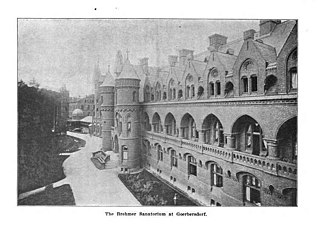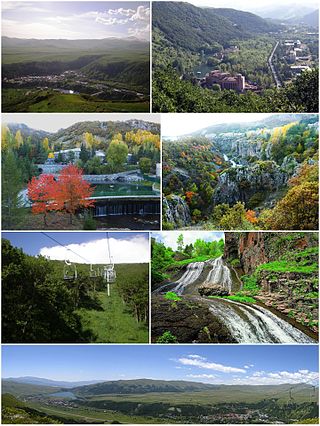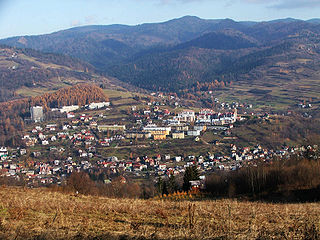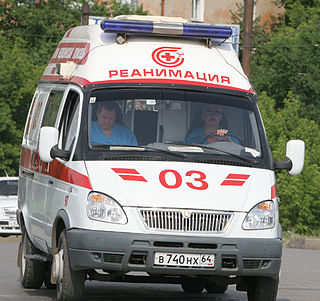
Sopot is a seaside resort city in Pomerelia on the southern coast of the Baltic Sea in northern Poland, with a population of approximately 40,000. It is located in Pomerania Province and has the status of county – the smallest city in Poland to have that status. Sopot lies between the larger cities of Gdańsk to the southeast and Gdynia to the northwest. The three cities together form the Tricity metropolitan area.

Urban-type settlement is an official designation for lesser urbanized settlements, used in several Central and Eastern European countries. The term was primarily used in the Soviet Union and later also for a short time in socialist Bulgaria and socialist Poland. It remains in use today in nine of the post-Soviet states.

A sanatorium, also sanitarium or sanitorium, is a historic name for a specialised hospital for the treatment of specific diseases, related ailments and convalescence. Sanatoriums are often in a healthy climate, usually in the countryside. The idea of healing was an important reason for the historical wave of establishments of sanatoria, especially at the end of the 19th- and early 20th centuries. One sought, for instance, the healing of consumptives especially tuberculosis or alcoholism, but also of more obscure addictions and longings of hysteria, masturbation, fatigue and emotional exhaustion. Facility operators were often charitable associations such as the Order of St. John and the newly founded social welfare insurance companies.
Sanitarium or sanatorium may refer to:

Yessentuki is a city in Stavropol Krai, Russia, located in the shadow of Mount Elbrus at the base of the Caucasus Mountains. The city serves as a railway station in the Mineralnye Vody—Kislovodsk branch, and is located 43 kilometers (27 mi) southwest of Mineralnye Vody and 17 kilometers (11 mi) west of Pyatigorsk. It is considered the cultural capital of Russia's Greek population and close to ten percent of its population is of Greek descent. Population: 119,658 (2021 Census); 100,996 (2010 Russian census); 81,758 (2002 Census); 85,082 (1989 Soviet census).

A feldsher is a health care professional who provides various medical services limited to emergency treatment and ambulance practice. As such, a feldsher is one kind of mid-level medical practitioner.

Yevpatoria is a Ukrainian city of regional significance in Western Crimea, north of Kalamita Bay. Yevpatoria serves as the administrative center of Yevpatoria Municipality, one of the districts (raions) into which Crimea is divided. It had a population of 105,719 .

A spa is a location where mineral-rich spring water is used to give medicinal baths. Spa towns or spa resorts typically offer various health treatments, which are also known as balneotherapy. The belief in the curative powers of mineral waters goes back to prehistoric times. Such practices have been popular worldwide, but are especially widespread in Europe and Japan. Day spas and medspas are also quite popular, and offer various personal care treatments.

Radioactive quackery is quackery that improperly promotes radioactivity as a therapy for illnesses. Unlike radiotherapy, which is the scientifically sound use of radiation for the destruction of cells, quackery pseudo-scientifically promotes involving radioactive substances as a method of healing for cells and tissues. It was most popular during the early 20th century, after the discovery in 1896 of radioactive decay. The practice has widely declined, but is still actively practiced by some.

Myrhorod is a city in Poltava Oblast, central Ukraine. It serves as the administrative center of Myrhorod Raion. Myrhorod also hosts the administration of Myrhorod urban hromada, one of the hromadas of Ukraine. It is located on the Khorol River. Population: 37,886.

Jermuk is a mountain spa town and the centre of the Jermuk Municipality of the Vayots Dzor Province in southern Armenia, at a road distance of 53 km (33 mi) east of the provincial capital Yeghegnadzor. It was considered one of the popular destinations for medical tourism in the Soviet Union.

Szczawnica is a resort town in Nowy Targ County in Lesser Poland Voivodeship, in southern Poland. As of June 30, 2007, its population was 7,378.

Tskaltubo is a spa resort in west-central Georgia. It is the main town of the Tsqaltubo Municipality of the Imereti province. It is known for its radon-carbonate mineral springs, whose natural temperature of 33–35 °C (91–95 °F) enables the water to be used without preliminary heating.

Truskavets is a city in Drohobych Raion, western Ukraine's Lviv Oblast (region), near the border with Poland. It hosts the administration of Truskavets urban hromada, one of the hromadas of Ukraine. The population is approximately 28,287.

Morshyn is a small city located at the Eastern Carpathian Foothills within Ukraine's Stryi Raion, Lviv Oblast (region). It hosts the administration of Morshyn urban hromada, one of the hromadas of Ukraine. The population is 5,562.

Vorokhta is a rural settlement located in the Carpathian Mountains on Prut River and is part of Nadvirna Raion, Ivano-Frankivsk Oblast. Historically, it is a tourist spa town and later was also turned into a ski resort with several ski-jumping ramps (Avanhard). Vorokhta hosts the administration of Vorokhta settlement hromada, one of the hromadas of Ukraine. Population: 4,207 ; due to a constant flow of tourists, its population almost year-round is bigger.

Barvikha is a village in Odintsovsky District of Moscow Oblast, Russia. It is the site of the Barvikha Sanatorium, the health resort of the President of Russia. During the Soviet era, Barvikha was known as the site of the most desirable state dachas for government officials and leading intellectuals. Since the late 1990s many of Russia's wealthiest individuals have built private luxury dachas in Barvikha. The village lies in an area nicknamed "Rublyovka", known as the most expensive area in Russia.

Healthcare in Russia is provided by the state through the Federal Compulsory Medical Insurance Fund, and regulated through the Ministry of Health. The Constitution of the Russian Federation has provided all citizens the right to free healthcare since 1993. In 2008, 621,000 doctors and 1.3 million nurses were employed in Russian healthcare. The number of doctors per 10,000 people was 43.8, but only 12.1 in rural areas. The number of general practitioners as a share of the total number of doctors was 1.26 percent. There are about 9.3 beds per thousand population—nearly double the OECD average.

Shohimardon is a village and a subdivision of Fergana District, Fergana Region in eastern Uzbekistan. It is an exclave of Uzbekistan, surrounded by Kyrgyzstan, in a valley in the Pamir-Alay mountains. The name means ‘King of Men’ in Persian. The river Shohimardonsoy flows through the exclave. There are two villages: Shohimardon and Yordon.

Sanatorium "Alatau" is a health-improving, medical-preventive sanatorium located in Almaty, Kazakhstan.



















